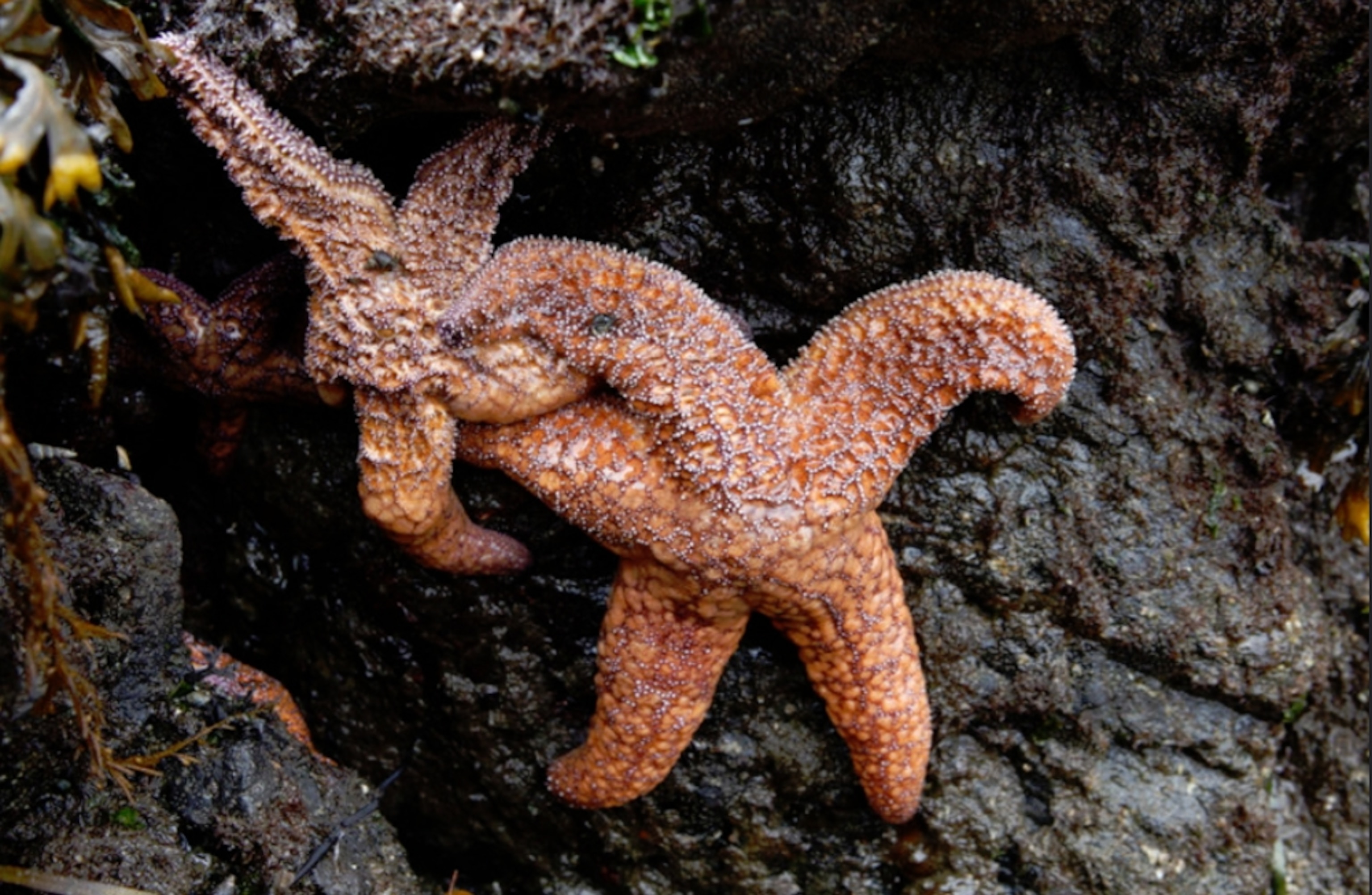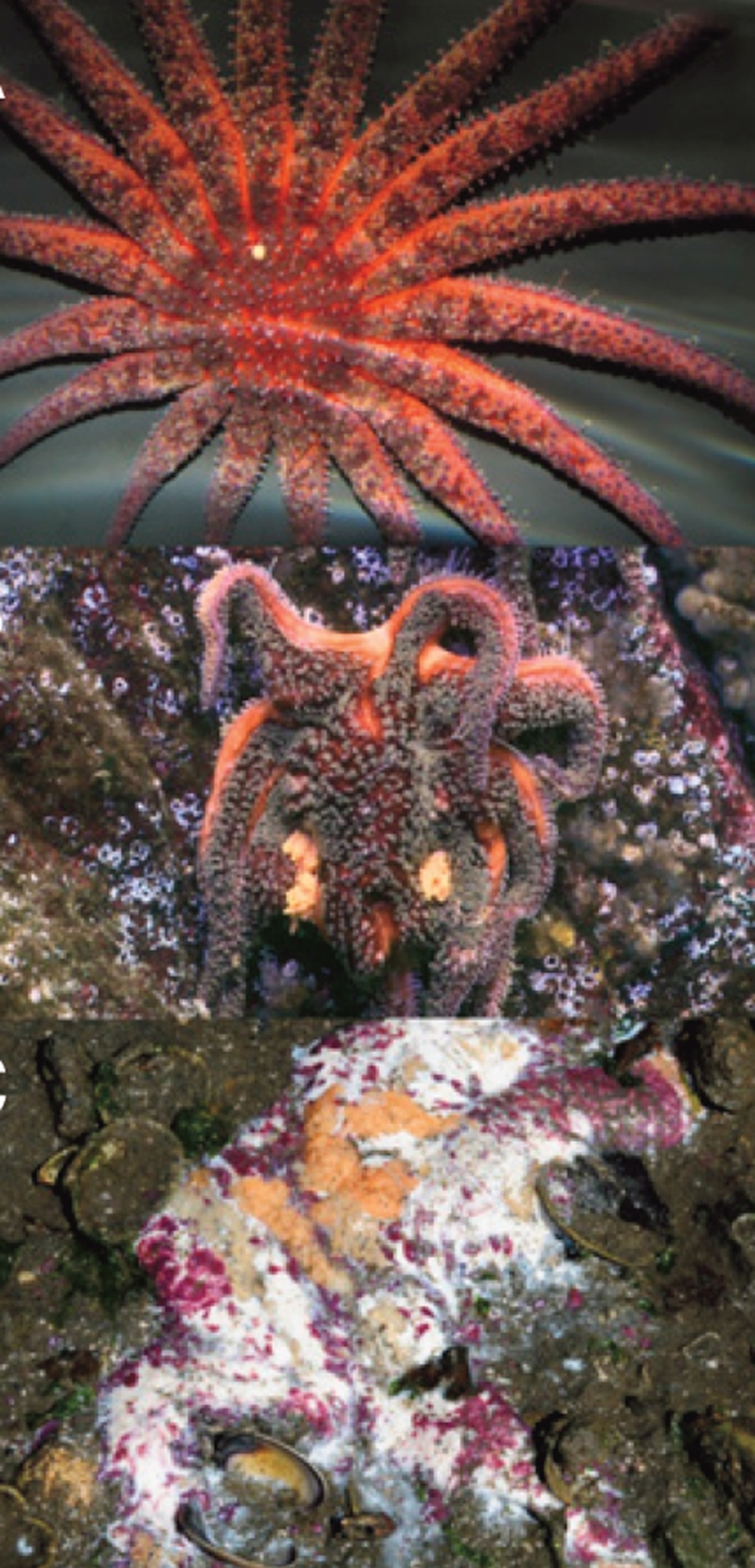
The Fault in Our Stars Might be a Virus
In June 2013, starfish on the western coast of North America started wasting away. At first, their arms curled from the tips, and they tied themselves into pretzel-like knots. Their bodies deflated. White festering sores appeared on their flesh. As the lesions spread, their flesh rotted away and their arms fell off. Within days, healthy animals had disintegrated into mush.
This condition, known as sea star wasting syndrome (SSWS), was recorded as far back as the 1970s, but the scale of this recent event is unprecedented. It has hit at least 20 species all along the Pacific, from Alaska to California. In less than a year, huge, thriving populations have completely wasted away.
As the stars blinked out, scientists compiled a list of possible causes that included storms, rising temperatures, and pollutants. But an infection always seemed likely. The disease seemed to move from place to place with the character of a spreading epidemic. Most tellingly, starfish in aquariums started dying too. These animals were housed in controlled captive environments but they were immersed in water pumped in from the surrounding ocean—and that was enough to kill them. Filtering the water through sand didn’t help. The only measure that spared the stars was sterilising the water with ultraviolet light. Whatever was killing the animals was microscopic and biological.
Now, a team of scientists led by Ian Hewson from Cornell University have identified the most likely culprit behind the grisly outbreak—a new virus that they call sea star-associated densovirus, or SSaDV.

Densoviruses are best known for infecting insects and crustaceans, but last year, Hewson’s team discovered them in a group of Hawaiian sea urchins. “We didn’t associate those viruses with any disease,” he says. “I jokingly told a colleague: Boy, what if there was some kind of mass mortality?” When the SSWS outbreak hit, the team leapt at the chance to study it.
First, they blended tissues from wasting starfish and passed them through filters with extremely small pores—small enough to exclude bacteria but big enough to let viruses through. They inoculated healthy starfish with these extracts, and the animals started wasting within a couple of weeks. If they boiled the extracts first, the animals were unharmed. This confirmed that the disease was transmissible and was caused by something the size of a virus. By sequencing the killer extract, the team showed that it contained the genome of a new densovirus—SSaDV.
They then collected tissue samples from 465 wild starfish, belonging to three species. The symptomatic animals were more likely to carry SSaDV than their healthy peers, and in higher numbers. And the more viruses they had, the worse their symptoms were.
The association wasn’t perfect: some diseased starfish showed no signs of the virus, while some healthy ones did. But Hewson thinks that there are easy explanations for these patterns. Diseases animals don’t have the virus everywhere. “If you take a sea star and divide it into pieces, you can detect virus in 80 percent of them. So 20 percent will be a false negative,” he says. There’s also a lag between infection and symptoms, so “healthy” animals might be exposed without having fallen sick yet. “Some of the ‘healthy’ samples came from an aquarium where all the animals later died,” Hewson adds.
“The authors present persuasive evidence that they have identified an agent associated with SSWS,” says Ian Lipkin, a virus hunter from the Mailman School of Public Health. “Nonetheless, as they note themselves, there is much more work to be done before we will know whether the densovirus they describe is necessary and sufficient to cause disease.”
Vincent Racaniello, a virologist from Columbia University, agrees that the evidence is strong. “The crucial experiment that remains to be done is to isolate infectious virus in cell culture, inoculate it into sea stars, and show that it causes wasting disease,” he says.
Hewson agrees that this step is crucial, but he also thinks that it will be very difficult. Ideally, he’d like to infect starfish in the absence of all other microbes to show that the virus is truly responsible for the disease. But these animals pump seawater through their bodies and they are naturally riddled with microbes. The alternative is to grow starfish tissues in the lab, but no such cultures exist for marine invertebrates. “That’s a real stumbling block,” says Hewson. “We’re trying to isolate a cell culture of a sea star but that’ll be a long and tedious process.
He also suspects that the virus may not actually cause the symptoms of SSWS directly. It could, for example, disrupt the sea stars’ ability to control the bacteria that they normally co-exist with. “The lesions are probably just the native bacteria taking advantage of an immunocompromised host,” he speculates. “So, associating the virus with those lesions may be a challenge.”
There’s also another mystery: why is the current outbreak of SSWS so dramatic when the newly discovered virus is actually an old presence? The team found its DNA within starfish that had been collected from the Pacific coast as far back as 1942, and that have been sitting in museum jars ever since. So why weren’t North America’s starfish melting away while World War II was raging?
“Viruses do smoulder in populations,” says Hewson. Familiar names like HIV and Ebola were affecting humans at small scales long before they triggered huge scary epidemics. The same may apply to SSaDV. In recent years, booming sea star populations in the Pacific Northwest may have given the virus newfound impetus. “There were mountains of sea stars underwater, tens of metres high,” says Hewson. “If you talk to crab-fishers in the region, their crab pots were full of these stars and they were getting annoyed.” The virus could have more easily jumped from host to host, or developed mutations that made it more transmissible or virulent.
Environmental changes may be important. Carol Blanchette from the University of Santa Barbara says, “We have been sampling sea stars across southern California throughout this epidemic and it is likely that in our region, as well as in others, environmental causes like increased temperatures have played an important role.” She finds the virus evidence convincing, but thinks it “may only be one part of the story”.
SSaDV may just be part of a natural cycle that controls sea star populations if they grow too big. Then again, some starfish act as keystone species—they wield disproportionate influence over their habitats by controlling populations of mussels and barnacles that would otherwise takeover. Their loss could dramatically reshape the coastlines of the Pacific Northwest, from thriving communities into black mussel monocultures.
SSaDV is also found in other related animals like sea urchins and brittle stars. No one knows if it causes disease in these groups, but the worry is that the virus could use its sea star hosts as a platform for building in numbers and launching outbreaks in other species.
Even if that was true, Hewson doubts that anything can be done. Even if scientists could develop a cure or vaccine, it would be impractical to inoculate the animals on a wide scale. “We’re just trying to understand this as a natural phenomenon,” he says.
Reference: Hewson, Button, Gudenkauf, Miner, Newton, Gaydos, Wynne, Groves, Hendler, Murray, Fradkin, Breitbart, Fahsbender, Lafferty, Kilpatrick, Miner, Raimondi, Lahner, Friedman, Daniels, Haulena, Marliave, Burgem, Eisenlord & Harvell. 2014. Densovirus associated with sea-star wasting disease and mass mortality. http://dx.doi.org/10.1073/pnas.1416625111
